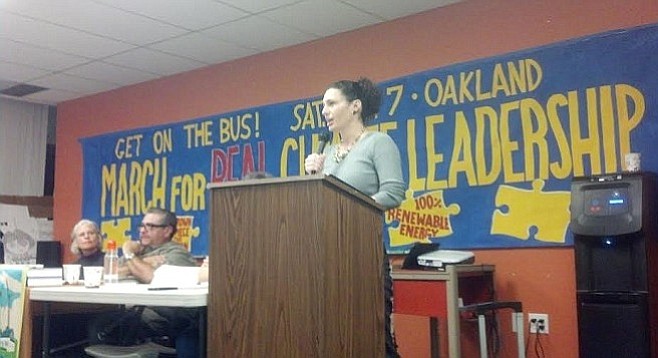 Facebook
Facebook
 X
X
 Instagram
Instagram
 TikTok
TikTok
 Youtube
Youtube

Environmental activists packed a meeting hall at King-Chavez Community High School downtown on Monday night, January 12, for the first stop of the California Crossroads Tour, meant to raise awareness and pressure state government to take action toward banning the practice of hydraulic fracturing mining (known as "fracking") and continue to move toward renewable energy sources for power generation.
"People are getting poisoned by fracking," said David Braun, representing Californians Against Fracking. "People are getting poisoned by urban oil drilling, by living next to oil refineries. And they're expanding refineries, expanding fracking — they're taking hydrochloric acid and shooting it into the ground to melt away rock, we're so desperate for oil."
Despite the rush to expand fracking wells across the country, Braun and others say it's an inefficient process, requiring the equivalent of a barrel of oil's worth of energy to extract five barrels from the ground. Joy Williams of the Environmental Health Coalition said that up to 2000 local trips by trucks transporting equipment, water, and chemicals were involved in the drilling of a single well. As much as two million gallons of water is used daily for existing fracking operations within the state, despite ongoing severe drought conditions.
It's not just Central California and its massive Monterey Shale gas and oil deposits that will be affected by mining operations, activist José Brao said — a massive liquefied natural gas storage and processing facility near Ensenada, Energia Costa Azul, was built to process up to one billion cubic feet of gas per day, much of it shipped through San Diego County via existing pipelines.
"There may be a political fence" along the border, says Brao, "but we share the same air, the same watershed, and there's plenty of pollution flowing back across generated by U.S. corporations who've set up shop in Mexico."
Micah Mitrosky, representing the local electrical workers' union, says progress is being made — in 2013, the most recent year for which statistics are available, union members logged 1.6 million hours working on renewable-energy projects, roughly a quarter of all hours worked that year. Not counting a considerable body of work by non-union contractors, over 1000 megawatts of renewable-power generation has been installed locally in recent years (roughly enough to replace one of the two defunct nuclear reactors at San Onofre).
The labor body is lobbying for more investment in geothermal power, which can generate clean energy around the clock, unlike solar power, and for power-storage projects that would make expanded adoption of renewable energy more feasible.
The tour will continue through California in coming weeks, culminating with a March for Climate Leadership in Oakland on February 7.


Environmental activists packed a meeting hall at King-Chavez Community High School downtown on Monday night, January 12, for the first stop of the California Crossroads Tour, meant to raise awareness and pressure state government to take action toward banning the practice of hydraulic fracturing mining (known as "fracking") and continue to move toward renewable energy sources for power generation.
"People are getting poisoned by fracking," said David Braun, representing Californians Against Fracking. "People are getting poisoned by urban oil drilling, by living next to oil refineries. And they're expanding refineries, expanding fracking — they're taking hydrochloric acid and shooting it into the ground to melt away rock, we're so desperate for oil."
Despite the rush to expand fracking wells across the country, Braun and others say it's an inefficient process, requiring the equivalent of a barrel of oil's worth of energy to extract five barrels from the ground. Joy Williams of the Environmental Health Coalition said that up to 2000 local trips by trucks transporting equipment, water, and chemicals were involved in the drilling of a single well. As much as two million gallons of water is used daily for existing fracking operations within the state, despite ongoing severe drought conditions.
It's not just Central California and its massive Monterey Shale gas and oil deposits that will be affected by mining operations, activist José Brao said — a massive liquefied natural gas storage and processing facility near Ensenada, Energia Costa Azul, was built to process up to one billion cubic feet of gas per day, much of it shipped through San Diego County via existing pipelines.
"There may be a political fence" along the border, says Brao, "but we share the same air, the same watershed, and there's plenty of pollution flowing back across generated by U.S. corporations who've set up shop in Mexico."
Micah Mitrosky, representing the local electrical workers' union, says progress is being made — in 2013, the most recent year for which statistics are available, union members logged 1.6 million hours working on renewable-energy projects, roughly a quarter of all hours worked that year. Not counting a considerable body of work by non-union contractors, over 1000 megawatts of renewable-power generation has been installed locally in recent years (roughly enough to replace one of the two defunct nuclear reactors at San Onofre).
The labor body is lobbying for more investment in geothermal power, which can generate clean energy around the clock, unlike solar power, and for power-storage projects that would make expanded adoption of renewable energy more feasible.
The tour will continue through California in coming weeks, culminating with a March for Climate Leadership in Oakland on February 7.
Comments